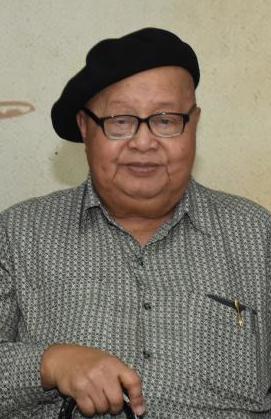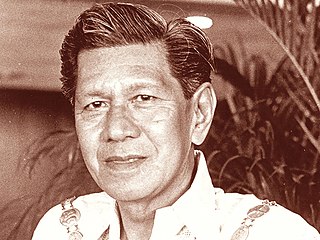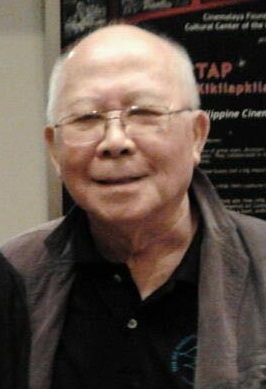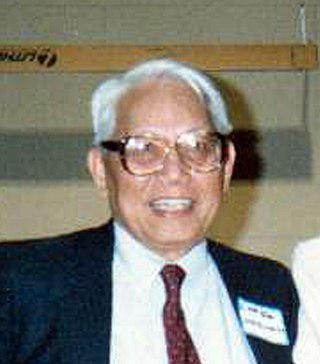Carlos Sampayan Bulosan was a Filipino American novelist and poet who immigrated to the United States on July 1, 1930. He never returned to the Philippines and he spent most of his life in the United States. His best-known work today is the semi-autobiographical America Is in the Heart, but he first gained fame for his 1943 essay on The Freedom from Want.

Francisco Sionil José was a Filipino writer who was one of the most widely read in the English language. A National Artist of the Philippines for Literature, which was bestowed upon him in 2001, José's novels and short stories depict the social underpinnings of class struggles and colonialism in Filipino society. His works—written in English—have been translated into 28 languages, including Korean, Indonesian, Czech, Russian, Latvian, Ukrainian and Dutch. He was often considered the leading Filipino candidate for the Nobel Prize in Literature.

Nicomedes "Nick" Marquez Joaquin was a Filipino writer and journalist best known for his short stories and novels in the English language. He also wrote using the pen name Quijano de Manila. Joaquin was conferred the rank and title of National Artist of the Philippines for Literature. He has been considered one of the most important Filipino writers, along with José Rizal and Claro M. Recto. Unlike Rizal and Recto, whose works were written in Spanish, Joaquin's major works were written in English despite being literate in Spanish.
Ilocano literature or Iloko literature pertains to the literary works of writers of Ilocano ancestry regardless of the language used - be it Ilocano, English, Spanish or other foreign and Philippine languages. For writers of the Ilocano language, the terms "Iloko" and "Ilocano" are different. Arbitrarily, "Iloko" is the language while "Ilocano" refers to the people or the ethnicity of the people who speak the Iloko language. This distinction of terms however is impractical since a lot of native Ilocanos interchange them practically.

Amado Vera Hernandez, was a Filipino writer and labor leader who was known for his criticism of social injustices in the Philippines and was later imprisoned for his involvement in the communist movement. He was the central figure in a landmark legal case that took 13 years to settle.

The Don Carlos Palanca Memorial Awards for Literature, popularly known as the Palanca Awards, are a set of literary awards for Philippine writers. Usually referred to as the "Pulitzer Prize of the Philippines," it is the country's highest literary honor in terms of prestige. It was named after Carlos Palanca Sr., the Chinese Filipino businessman and philanthropist.
Philippine literature in English has its roots in the efforts of the United States, then engaged in a war with Filipino nationalist forces at the end of the 19th century. By 1901, public education was institutionalized in the Philippines, with English serving as the medium of instruction. That year, around 600 educators in the S.S. Thomas were tasked to replace the soldiers who had been serving as the first teachers. Outside the academe, the wide availability of reading materials, such as books and newspapers in English, helped Filipinos assimilate the language quickly. Today, 78.53% of the population can understand or speak English.

Biag ni Lam-ang is an epic story of the Ilocano people from the Ilocos region of the Philippines. It is notable for being the first Philippine folk epic to be recorded in written form, and was one of only two folk epics documented during the Philippines' Spanish Colonial period, along with the Bicolano epic of Handiong. It is also noted for being a folk epic from a "Christianized" lowland people group, with elements incorporated into the storytelling.
Liwayway is a leading Tagalog weekly magazine published in the Philippines since 1922. It contains Tagalog serialized novels, short stories, poetry, serialized comics, essays, news features, entertainment news and articles, and many others. In fact, it is the oldest Tagalog magazine in the Philippines. Its sister publications are Bannawag, Bisaya Magasin, and Hiligaynon.

The Ilocanos, Ilokanos, or Iloko people are the third largest Filipino ethnolinguistic group. They mostly reside within the Ilocos Region, in the northwestern seaboard of Luzon, Philippines. The native language of the Ilocano people is the Ilocano language.

Bienvenido L. Lumbera was a Filipino poet, critic and dramatist. Lumbera is known for his nationalist writing and for his leading role in the Filipinization movement in Philippine literature in the 1960s, which resulted in his being one of the many writers and academics jailed during Ferdinand Marcos' Martial Law regime. He received the Ramon Magsaysay Award for Journalism, Literature and Creative Communications in 1993, and was proclaimed a National Artist of the Philippines for literature in 2006. As an academic, he is recognized for his key role in elevating the field of study which would become known as Philippine Studies.

Marjorie Evasco is a Filipina poet. She writes in two languages: English and Cebuano-Visayan and is a supporter of women's rights, especially of women writers. Marjorie Evasco is one of the earliest Filipina feminist poets. She is a recipient of the S.E.A. Write Award.

Néstor Vicente Madali González was a Filipino novelist, short story writer, essayist and, poet. Conferred as the National Artist of the Philippines for Literature in 1997.
Epifanio San Juan Jr., also known as E. San Juan Jr., is a known Filipino American literary academic, Tagalog writer, Filipino poet, civic intellectual, activist, writer, essayist, video/film maker, editor, and poet whose works related to the Filipino Diaspora in English and Filipino writings have been translated into German, Russian, French, Italian, and Chinese. As an author of books on race and cultural studies, he was a "major influence on the academic world". He was the director of the Philippines Cultural Studies Center in Storrs, Connecticut in the United States. In 1999, San Juan received the Centennial Award for Achievement in Literature from the Cultural Center of the Philippines because of his contributions to Filipino and Filipino American Studies.
Philippine literature in Spanish is a body of literature made by Filipino writers in the Spanish language. Today, this corpus is the third largest in the whole corpus of Philippine literature. It is slightly larger than the Philippine literature in the vernacular languages. However, because of the very few additions to it in the past 30 years, it is expected that the former will soon overtake its rank.

Ermita: A Filipino Novel is a novel by the known Filipino author F. Sionil Jose written in the English language. A chapter of this novel was previously published as a novella in the books titled Two Filipino Women and Three Filipino Women.
Filipino women writers have played important roles within Philippine literature, with Philippine women having created enduring works of fiction and non-fiction across the genres. Writing in English, Spanish, Filipino and other local languages and native dialects, female writers from the Philippine archipelago utilized literature, in contrast with the oral tradition of the past, as the living voices of their personal experiences, thoughts, consciousness, concepts of themselves, society, politics, Philippine and world history. They employed the "power of the pen" and the printed word in order to shatter the so-called "Great Grand Silence of the Centuries" of Filipino female members, participants, and contributors to the progress and development of the Philippine Republic, and consequently the rest of the world. Filipino women authors have "put pen to paper" to present, express, and describe their own image and culture to the world, as they see themselves.
Ligaya G. Tiamson-Rubin, is a Filipino writer. A multiple Carlos Palanca Memorial Awards for Literature recipient, and currently a professor of the University of the Philippines Diliman. Today, she is teaching Filipino 25, Mga Ideya at Estilo under the Department of Filipino and Philippine Literature at the College of Arts and Letters, University of the Philippines Diliman in Diliman, Quezon City.
Nick Carbó is a Filipino-American writer from Legazpi, Albay, Philippines. Carbó writes poetry, essays, and edits magazines and anthologies. He is primarily known for his book of poetry titled Secret Asian Man (2000) Tia Chucha Press which won the Asian American Writers Workshop's Readers Choice Award. He also won the 2005 Calatagan Award from the Philippine American Writers & Artists for his book Andalusian Dawn (2004) Cherry Grove Collections. His most noted award is the 1999 Gregory Millard/New York City Department of Cultural Affairs New York Foundation for the Arts Fellowship.

Leon Pichay was a writer and poet from the Philippines. Pichay was one of the most active Ilocano writers of his time. He wrote short stories, plays, novels, essays and more than 400 poems. He was known as the 'King of Ilocano Poets' during the 1950s.












